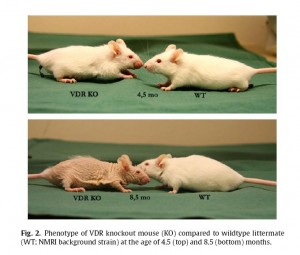A significant number of our readers have hypothyroidism with normal T4 but low T3. For instance, Kratos:
I followed a strict low carb diet with around 50g of carb per day for over 1 year and I think I have developed hypothyroidism …
TSH 3.4 (0.3-4.0)
FT3 2.2 (2.1-4.9)
FT4 11.4 (6.8-18.0)
This situation can have many causes. Our last post discussed how shift work and disrupted circadian rhythms can cause hypothyroidism. Another often-overlooked cause of hypothyroidism is nutrient deficiencies.
As noted in the book, selenium and iodine deficiencies are classic causes of hypothyroidism. Here I want to look at a few other possiblities.
Copper and Iron Deficiency
Copper deficiency, iron deficiency, and iodine deficiency during pregnancy or infancy generate similar neurological defects, and during adulthood generate similar hypothyroid symptoms:
Cu, Fe, and iodine/TH deficiencies result in similar defects in rodent brain development, including hypomyelination of axons, aberrant hippocampal structure and function, altered brain energy metabolism, and altered neuronal signaling (8–13). In addition, the behavioral and neurochemical abnormalities associated with perinatal Cu, Fe, and iodine/TH deficiencies are irreversible and persist into adulthood (14–16). These similarities suggest that there may be a common underlying mechanism associated with all three deficiencies contributing to the observed neurodevelopmental defects.
Several studies in postweanling rodents show that Cuand Fe deficiencies impair thyroid metabolism. Fe deficiency reduces circulating thyroxine (T4) and triiodothyronine (T3) concentrations (17–20), peripheral conversion of T4 to T3 (18, 19), TSH response to TRH (19), and thyroid peroxidase (TPO) activity (20). Cu deficiency also reduces circulating T4 andT3 concentrations and peripheral conversion of T4 to T3 (21, 22). In addition, Cu deficiency reduces serum and brain Fe levels, which may contribute to the Cu-dependent effect on thyroidal status (23). [1]
In infant rats, deficiencies of either copper or iron cause hypothyroidism:
Cu deficiency reduced serum total T(3) by 48%, serum total T(4) by 21%, and whole-brain T(3) by 10% at P12. Fe deficiency reduced serum total T(3) by 43%, serum total T(4) by 67%, and whole-brain T(3) by 25% at P12. [1]
Note that copper deficiency hypothyroidism reduces serum T3 levels more strongly than T4 levels, the same pattern that Kratos displays.
While We’re On the Topic of Micronutrients and Hypothyroidism …
Hypothyroidism induces the symptoms of riboflavin deficiency. This is because thyroid hormone is needed for production of the enzyme flavin kinase, which is in turn needed to generate flavin adenine dinucleotide (FAD). Riboflavin deficiency and thyroid hormone deficiency lead to the same low FAD levels in both rats and humans. [2]
This suggests that hypothyroid persons may wish to supplement with riboflavin, so that extra riboflavin may help make up for deficient flavin kinase.
Conclusion
I believe that those with health problems should strive to “overnourish” themselves. Micronutrient deficiencies can have insidious disabling effects, yet be impossible to diagnose. In disease conditions, needs for many micronutrients are increased. Many micronutrients are non-toxic up to fairly large doses and can be safely supplemented.
An effort to eat micronutritious foods and supplement micronutrients into their “plateau ranges” to eliminate deficiencies might generate startling health improvements.
Minerals like copper, selenium, and iodine are among the most important nutrients – they are among our eight essential supplements – yet also among the most widely deficient. Most supplementers neglect key minerals; but optimizing their intake can pay large health dividends.
References
[1] Bastian TW et al. Perinatal iron and copper deficiencies alter neonatal rat circulating and brain thyroid hormone concentrations. Endocrinology. 2010 Aug;151(8):4055-65. http://pmid.us/20573724.
[2] Cimino JA et al. Riboflavin metabolism in the hypothyroid newborn. Am J Clin Nutr. 1988 Mar;47(3):481-3. http://pmid.us/3348160.












Recent Comments